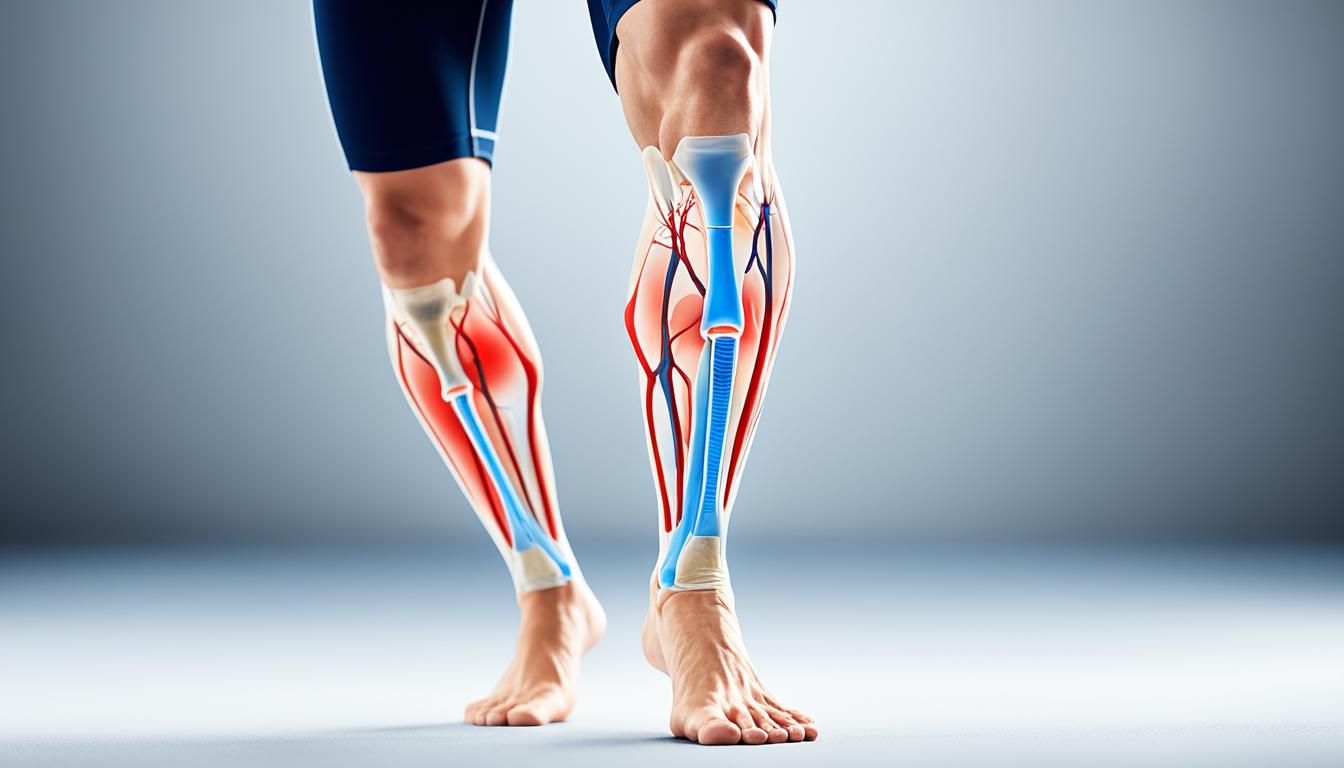Medial tibial stress syndrome, also known as shin splints or MTSS, is an injury from overuse. It causes pain along the inner edge of the shin bone. This happens often to athletes and those who run or jump a lot. It leads to bone stress or inflammation of the periosteum, which is the bone’s outer layer.
Symptoms include pain and tenderness along the inner shin that gets worse with activity. Diagnosis mostly comes from the patient’s history and a physical exam. But, tests like X-rays, CT scans, or MRI scans might be needed. These rule out other issues. General practitioners and orthopedic surgeons treat MTSS.
Treating MTSS usually involves rest, ice, and anti-inflammatory drugs. Sometimes painkillers are also used. In rare cases, surgery might be needed. But, now, we’re looking at new treatments like stem cell therapy. Stem cell therapy shows promise in helping tissues heal and reducing pain and swelling.
Key Takeaways:
- Medial tibial stress syndrome is a common overuse injury that causes pain along the inner edge of the shin bone.
- It is often seen in athletes and individuals who engage in activities that involve running and jumping.
- Symptoms include pain and tenderness along the inner shin, which can worsen with physical activity.
- Treatment options include rest, icing, anti-inflammatory medications, painkillers, and in severe cases, surgery.
- Stem cell therapy is an emerging treatment option for MTSS, showing promising results in reducing pain and promoting tissue regeneration.
Causes and Risk Factors of Medial Tibial Stress Syndrome
Medial tibial stress syndrome is known as shin splints. It can come from different reasons. Knowing these reasons is key to stop it from happening.
Overuse and Overtraining
Too much use is a big cause. This happens when you stress the tibia’s muscles and bone a lot. Often happens in running or jumping. Athletes in high-impact sports or those who train too much can get it easily.
Overpronation
Another risk is overpronation. This means your foot rolls inward too much when you walk or run. It can mess up how force moves in your leg. This adds more stress to the shin bone, possibly causing MTSS.
Stress Fractures
Stress fractures are cracks in the bone. They come from too much stress on the tibia. If not treated, they can lead to MTSS, bringing a lot of pain and trouble.
Chronic Compartment Syndrome
This is when there’s too much pressure in a muscle’s compartment. It squishes blood vessels and nerves, causing swelling and pain. This can add to the stress on the shin bone, leading to MTSS.
Flat Feet
Having flat feet or a very stiff arch can also raise the risk. When your foot doesn’t have good arch support, it can’t move right. This makes the tibia bear too much stress.
So, overuse, overpronation, stress fractures, compartment syndrome, and flat feet are the risk factors for MTSS. Knowing this helps people avoid it. They can pick the right activities and shoes to stay safe.
| Risk Factors | Description |
|---|---|
| Overuse | Repetitive and excessive stress on the muscles and bones of the tibia |
| Overpronation | Inward rolling motion of the foot during walking or running |
| Stress Fractures | Small breaks or cracks in the bone due to repetitive stress |
| Chronic Compartment Syndrome | Increased pressure within the muscle compartment |
| Flat Feet | Lack of proper arch support and instability of the feet |
Understanding and addressing these factors can keep MTSS away. It’s about being careful and making the right choices to keep the shins healthy.
Diagnosis and Treatment of Medial Tibial Stress Syndrome
Usually, diagnosing medial tibial stress syndrome (MTSS) means looking at the patient’s history and doing a physical exam. Doctors and surgeons listen carefully to what you say about your pain and where it is. They also ask about things like running or jumping that could have caused MTSS.
Sometimes, tests like X-rays or MRIs are needed to be sure of the diagnosis and check its seriousness. But, these tests aren’t always needed to know if it’s MTSS.
Treating MTSS often involves simple steps to ease pain and help it heal. Rest is key to let the leg recover and stop making the issue worse. Icing the sore spot can cut down on swelling and make you feel better. Doctors might also suggest pain relievers that fight inflammation.
Using the right shoes and inserts is important. It helps support your feet and fix how your legs move. These steps, along with physical therapy to strengthen leg muscles, can help a lot.
If basic treatments don’t work, shock wave therapy might be tried. This is a treatment that uses sound waves to heal and lessen pain. But, not every place offers this therapy.
Surgery is a last resort option for very few with severe MTSS that won’t get better. The surgery aims to release tight muscles, reducing pain and pressure.
To beat MTSS and stop it from coming back, you must train smartly. Don’t do too much too soon. Give your body time to recover between workouts. This helps avoid this kind of injury.
Conclusion
Shin splints, also known as medial tibial stress syndrome (MTSS), is a common issue. It causes pain along the inner part of the shin bone. This often happens to people who do lots of running or jumping, like athletes. To diagnose MTSS, doctors mainly look at your medical history and do a physical exam.
For some cases, they might also use imaging tests. These help make sure it’s MTSS and not something else causing the pain. When treating MTSS, you usually need to rest and do ice and take anti-inflammatory drugs.
You might also need painkillers. In serious situations, surgery could be the answer. Some new treatments, like stem cell therapy, are also being looked into for MTSS. If you have ongoing shin pain or think you might have MTSS, make sure to see a doctor right away.

